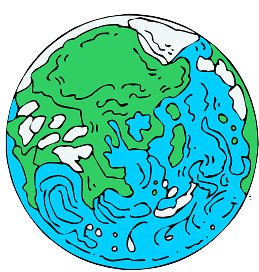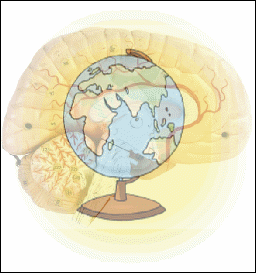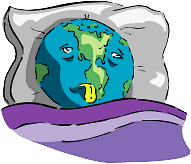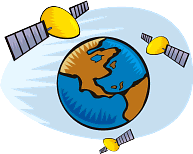
Does Gaia want rid of humans?

30th December 2021
James Lovelock [R.I.P. July 2022] in the Guardian, in an intervention at the start of the Glasgow COP-26 summit, suggests that the Covid pandemic may be Gaia’s first attempt to reduce the number of humans on the planet, and that this attempt being unsuccessful, we can expect “something nastier” in the future. Such a suggestion may hint at an activity of teleology on the part of the planet. But in his classic work of decades ago, Lovelock dismissed such an idea; the idea of planetary-level action to regulate its environment doesn’t require any degree of awareness, he says, since automatic responses to environmental stresses – as in his famous “Daisyworld” thought experiment – perform the task perfectly adequately. And there’s no reason to think that he’s changed his mind, as he still suggests that deterministic control theory, however complex in its implementation at planetary level, is adequate to explain the responses that we see.
Is this a reasonable position, or is there a more radical view that can be taken of the interaction of humanity and Mother Earth?

The basis for this discussion is the Hermetic saying “As above, so below”.
Some time ago, in his book The Awakening Earth (also published as The Global Brain) Peter Russell suggested that, if individual humans were regarded as nerve cells in the body of the planet, the number of cells (human population) that would allow the emergence of consciousness on the part of the planet could be correlated with the number of cells that has allowed consciousness to develop via the brain of the individual human body. At the time, his mathematics suggested that the figure of 10 billion (10.109) was about the same in both cases.
Checking on the figures, an early estimate of the total number of cells in the human body was 37.2. 1012; this was updated in 2016 by Sender, Fuchs and Milo [Revised Estimates for the Number of Human and Bacteria Cells in the Body, 2016] to 30. 1012 (30 trillion). Rather than a generalised cell, we may consider the individual human to have more the role of a neuron (“a specialized, impulse-conducting cell that is the functional unit of the nervous system”), on the planetary scale, as far as the function of planetary consciousness is concerned. This being the case, the 2016 work cited above suggests that neurons form about 0.3% of the total number of cells in the body. This works out to 90. 109 (90 billion). That’s about 10 times the number of humans on the planet.
But the figure derived by Sender et al is for the "Reference Man, defined as being between 20–30 years of age, weighing 70 kg, 170 cm in height.” Fortunately, their Table 3 considers other descriptions of human. Particularly, they mention a “young infant” (4 weeks) and an “infant” (1 year old). If we take the rough median of their figures for these two and assume a 6-month old infant, it will have a body weight of 7kg and a total cell count of 3. 1012. And if we then assume the same ratio of neurons to total cells, this means at age 6 months an infant has 9 billion neurons.
Parallel to this, the estimates of total human population on the planet are widely available and reasonably consistent; in a 2020 study by the Institute for Health Metrics and Evaluation (IHME) the global population was projected to peak in 2064 at 9·73 billion (in the range 8·84–10·9) people and decline to 8·79 billion (6·83–11·8) in 2100. This compares with a UN Population Division forecast global population in 2100 of 10·88 billion, a figure which according to the IHME study is optimistic in that it “does not allow for alternative scenarios linked to policies or other drivers of fertility and mortality”.
Taking the coincidence of these numbers at face value, it suggests that the level of “planetary consciousness” based entirely on humans as the embodiment of this consciousness, would be equivalent to a 6-month old infant on the human scale.
But what is meant by “humans as the embodiment of planetary consciousness”?
The question of “what is consciousness” has been around since at least the ancient Greeks, from Aristotle onwards. Modern philosophers have developed several ways of approaching the question; an extensive overview can be found in the Wikibooks document Consciousness Studies. But such approaches assume that what is being discussed is human self-reflective consciousness, that is, how individual humans are aware of themselves and their world. Mainstream philosophical discussion that steps outside this paradigm and considers consciousness as a phenomenon of wider application than just the human, is rare. The term “panpsychism” covers the concept that “everything in the world may be conscious; consciousness is a fundamental entity like energy. Conscious experience is then due to an interaction of conscious entities, personal conscious experience being centred on the individual.” Or as the physicist Sir Arthur Eddington put it in 1928, “The universe is of the nature of a thought or sensation in a universal Mind … To put the conclusion crudely — the stuff of the world is mind-stuff” [The Nature of the Physical World]. Panpsychism can hardly be considered mainstream, but is closest to the idea which is introduced here.
Peter Russell’s book describes the idea of planetary consciousness, but he is not the first. He himself references Père Teilhard de Chardin, who introduced the concept of the “noosphere”. Teilhard describes this as “the growth, outside and above the biosphere, of an added planetary layer, an envelope of thinking substance”. Observing the process of evolution from the formation of proteins up to the stage of the cell, then of individual cellular complexes up to and including man, he says “we are now at the formation of an organico-social super-complex, which can only occur in the case of reflective, personalized elements: mankind, born on this planet and spread over its entire surface, coming gradually to form around its earthly matrix a single, major organic unity, enclosed upon itself.” [The Future of Man (1964); for an overview of Teilhard’s ideas, see “Let Me Explain” Collins/Fontana 1973: ISBN 0-00-623379-1]
The idea is that evolution, at least on this planet and by extension throughout the cosmos, is in fact evolution of consciousness, rather than simply of material form. Peter Russell describes a stepping-stone progression, through atoms, molecules, cells, animal life, human life – at which point we develop self-aware consciousness, i.e. “knowing that we know” – and then puts the question, why should it stop there? Similarly, the Indian mystic and teacher Sri Aurobindo states that “there is a one Being and Consciousness involved here in Matter which is impelled to enlarge and develop towards a greater and greater perfection. Life and Mind are only the first two steps of this evolution [my italics]. The next step of the evolution must be towards development of a greater spiritual and supramental Consciousness”, which he calls “Supermind”.
But this implies that humanity, as a whole, has an essential part to play – essential in the sense that there is no other form of life that could play this part – in the development of consciousness at the planetary level. If every human being is a part of humanity, then each of us has a purpose that is higher and more important than our individual life: in the same sense as a cell has a purpose in the human body that is more important than the life of that cell alone. An individual cell can live and die, but in its life cycle it contributes to the structure of the body. Although it (probably) knows nothing of what a “body” is, through doing what it does and fulfilling its function correctly it maintains the vitality and integrity of that body. If it is the wrong type of cell or in the wrong place, it may harm the body’s integrity: this is what we call disease.

In the same way, an individual human can live and die, but through his or her life cycle we can contribute, in our own way and according to our individual abilities and merits, to the vitality and integrity of the planetary body. But here is where our understanding ends. As the cell cannot comprehend the totality of the body of which it is part, so a human does not have the understanding to be able to comprehend the totality of a planetary-level consciousness. In other words, we each may be a part of the planetary body, but we have no idea of the form of that body or what it is doing.
We can speculate, of course, as I’m doing here. And there are probably some people – such as Teilhard, Russell or Aurobindo – who have approached a fuller idea of what the next level of consciousness means, and who are trying to pass on that idea to the rest of us.
One important aspect of this idea is that whatever form this next level takes, it isn’t a material form. In the ladder of evolutionary progression from atoms – molecules – cells – through to plant, animal, human life, each next “rung” is of a finer degree than the previous: since humans have individually achieved self-reflective consciousness, the next rung is going to be a form of consciousness that is less materialist (or perhaps, more “spiritual”) than that.
Note that we’re not here talking about the sort of awareness which has been available to both humans and animals for millenia: the awareness of a connection with the natural world, which is manifested for example in the migration sense of animals or the sense of place of indigenous peoples. It’s easily arguable that modern man has lost this sense, and there is every reason to attempt to recover it. But this doesn’t of itself create the kind of evolution of planetary consciousness which is implied in Teilhard’s noosphere or Aurobindo’s Supermind.
What does this concept mean for the way in which we should develop as individual humans? We don’t, individually, have the ability to directly influence the direction of growth of the planetary being. But we do, individually, have the ability to help or to hinder it, just as a human body cell can help or hinder the growth of the body of which it is part. The vast majority of our cells, if we are healthy, are doing exactly what they should in the location and function in and for which they exist. A few aren’t; and if we are healthy, they are dealt with by the policing functions that the body’s evolution has provided (we call them T-cells or antibodies). If those functions are weak or missing, disease invades, and in the worst case leads to the dissolution of the body. If there are not enough of the proper cells, we are thin and emaciated; if there are too many, we are obese.
How can we translate this picture to a higher level of consciousness, at the planetary scale?
Here we can contrast and compare the paradigm of Individualism with the paradigm of Co-Operation. In order for human individuals to work for the planetary consciousness, they have to co-operate, with each other and with a sense of Gaia as a being. For millenia, the prevailing paradigm has been that the individual human’s will is paramount. As society has evolved, so aspects of individualism have become subordinated to the needs of an individual’s social context; but until recently that has not extended to the planetary context. In On Liberty, the philosopher J S Mill said that society’s laws should not control actions that do not violate the rights of any particular individuals, whether or not these actions are morally good or bad. This precept has determined the position of libertarian politics right up to the present time. Parallel to this, socialist politics has developed, in which individuals are absolutely required to conform to social norms; and the contrast between these two political strains has created the global battles that have played out in the last couple of centuries, most typically between what is known as Western Democracy and the various forms of Eastern communism.
Depending on your preference, you may be expecting one or other of these strains to prevail. But the pressure on the whole human race, particularly in the last decade, has been in the direction of curtailment of individual freedoms. Two immediate crises are pushing this: the global Covid pandemic (as Lovelock indicated), and the threat of climate change. Covid is constricting people’s behaviour, in order to protect not only each other but also their country’s social infrastructure, particularly the health infrastructure. We are encouraged (in some cases, required) to “get a jab”, to wear a mask, to observe “social distancing”, to be “locked down”. This is a fundamental shift towards a co-operative ethos; the backlash from individualists who see their sacrosanct personal rights being overturned only emphasizes this.
The pandemic is really a dress rehearsal for the climate crisis. Many more of the individual rights – for instance, to drive your car where and when you like, to burn gas or coal just to heat your own home, to enjoy beefburgers and steaks, to fly off for a holiday in the sun – will become untenable as the crisis unfolds.
Co-operation, of course, has always been a feature of society, indeed you can argue that the very notion of “society” has co-operative effort embedded within it. But this feature is limited in scope. Wherever social constraints don’t intrude, there is where the individual rights dominate.

Parallel to these pressures towards co-operation, another dimension is the revolution in communication. In short order over the last 100 years, we have had the wired telephone, radio and television, fast long-distance travel, the internet, and mobile and smart phones. Communication allows and encourages enhanced co-operation. To return to the human cell context, it is argued that self-reflective consciousness is not just a function of the number of neurons, but also of their connectivity. The interconnectedness of a huge number of neurons coupled through an even larger number of pathways between them allows an entity to appear – the human consciousness – that is not uniquely traceable to any material component in the physical human body. Hence the plethora of ideas about the “location” of consciousness, none of which appear to be provable. Without the interconnections, ten billion brain cells would just be a bowl of thick soup.
Alongside communication technologies, data storage and manipulation has become universal, at least in developed countries. Information technology is moving towards an explosion in Artificial Intelligence (AI) – for a comprehensive and largely upbeat review of this, see Max Tegmark’s book Life 3.0 (ISBN 978-0-241-23719-9). The doomsday scenario for AI is that it will, in quite a short time – some pundits talk about a couple of decades – render human intelligence redundant. Doomsday scenarios tend not to be fulfilled, at least in the way that their adherents expect; but one direct consequence of the existing applications of AI is enhanced surveillance of the human population. Think of facial recognition or automatic numberplate recognition of vehicles, both applications which are already widespread. (The Driver and Vehicle Licensing Agency says “we can always spot an unlicensed vehicle” – they couldn’t say that until recently.) The net effect of such technological progress is to enforce a population’s compliance with social norms to a degree never before achieved: co-operation again – that is, co-operate or else.
Overall, then, what we find in the context of evolution of a planetary consciousness is that the number of entities (people, for the time being) on the planet that could host that consciousness is moving rapidly towards a sustainable value. At the same time, the communication mechanisms between entities that will allow its emergence are also now available. And the functional requirement that the entities shall co-operate to provide the host with its conscious “body” is also being developed, perhaps voluntarily and perhaps by enforcement. Consequently, to answer the question posed by the title of this piece, Gaia doesn’t want rid of humans: she needs us, but she wants us in our proper place.
A human birth is traumatic – there is no reason to think that a planetary birth would not be. But we are not now talking about physical trauma. What we are looking at is the birth of a level of consciousness, beyond the consciousness that we are familiar with. So the type of trauma that should be expected would be at this higher level; and indeed, all the difficulties and eccentricities of human mental health that have become prevalent over recent decades – such as depression, anxiety, PTSD, bipolar disorder, suicidal thoughts and self-harm, all the way up to inter-societal conflict and the two world wars – could be seen as a manifestation at the human level of the birth trauma of the planetary being.
But what is the difference between an infant planet and an adult planet?
To return to our starting point, if we take an absolute correspondence between the number of entities, it would require 10 times the number of humans soon to be on the planet before the planet could be said to be “adult”. For now, the emerging planetary consciousness is only an infant. This should not be either surprising or concerning; why should the process of growth be any different on different levels of being? For a planetary being to spring into existence fully formed and functioning at the age of 0.5 would at the very least offend our ideas of good sense.
It may, of course, not be the case that there is such an absolute correspondence in number, in which case speculation as to the practical “age” of the planet is redundant. But if we take the correspondence further, it implies that as the planet grows towards adulthood we would need to see an increase of around ten times the number of conscious entities, to support the adult being. It’s hard to see this occurring if such entities are individual humans. The planet’s physical body couldn’t support that number of human bodies, even if all other constraints were overcome. In the context of the unfolding crises, there is a school of thought which says it can’t even support the existing number for long, and the various changes to be expected in the next few decades will turn out to be a means of “pruning” the human population – perhaps the “something nastier” of Lovelock’s vision.
However, this may be the real meaning of the explosion in AI. Internet nodes (computers and their descendants) don’t take physical resources in the way humans do: their only food is electricity, and they can be microscopically small. We can already see the development of machine-to-machine interconnectedness, what is known in the industry as the “Internet of Things”. 9 billion humans supported by 90 billion AI cells is entirely feasible in physical terms. Whether the 90 billion AI cells would be self-supporting, or whether the planet would need the 9 billion co-operating and communicating humans as well, is perhaps the most significant question facing the “human race”. But it seems totally believable that a synthesis of human consciousness with AI is the next step which enables the nascent planetary baby to grow into adulthood. All we have to do is give up our extremes of rugged individualism, co-operate with each other and the planet, and accept our part in its future.